iPhone 12 Pro vs. iPhone 12 Pro Max: Which should you buy?
Is the iPhone 12 Pro Max worth the extra $100?
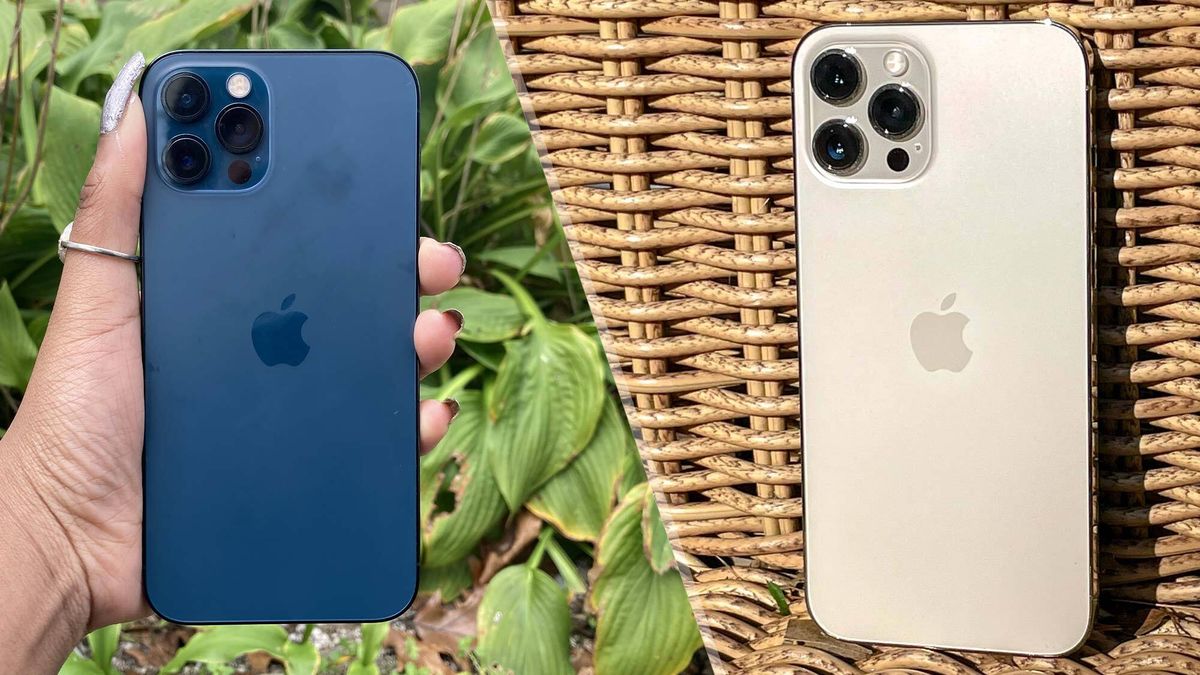
iPhone 12 Pro vs. iPhone 12 Pro Max is the savage catfight — meow! — you’ll want to watch if you're uncertain whether the Pro Max model is worth the extra $100. The iPhone 12 Pro and the iPhone 12 Pro Max share many similarities, including a Super Retina XDR OLED display, a rear triple-camera setup, and the A14 bionic chip (the world’s fastest smartphone processor).
So what, exactly, are the differences between the iPhone 12 Pro and the iPhone 12 Pro Max? Aside from specs, we’ll dive into the lab results we’ve collected for Apple’s upper-tier iPhone 12 darlings, including battery runtimes, overall performance and color-spectrum coverage, to make it clear which device is the better investment.
After watching these two high-end smartphones battle it out in the ring, you’ll know which iPhone 12 — the Pro or the Pro Max — you should place your bets on. Without further ado, let the face-off begin.
| Row 0 - Cell 0 | iPhone 12 Pro | iPhone 12 Pro Max |
| Starting price | $999 | $1,099 |
| Display | 6.1-inch, OLED, Super Retina XDR (2532 x 1170 , 60Hz) | 6.7-inch, OLED, Super Retina XDR (2778 x 1284, 60Hz) |
| CPU | Apple A14 Bionic | Apple A14 Bionic |
| RAM | 6GB | 6GB |
| Storage | Starts at 128GB | Starts at 128GB |
| Rear cameras | 12MP f/1.6 (Wide-angle), 12MP f/2.4 (ultra-wide), 12MP f/2.0 (Telephoto) | 12MP f/1.6 (Wide-angle), 12MP f/2.4 (ultra-wide), 12MP f/2.2 (Telephoto) |
| Front camera | 12MP, f/2.2 aperture, TrueDepth | 12MP, f/2.2 aperture, TrueDepth |
| Battery size | 2,815 mAh | 3,867 mAh |
| Water resistance | Yes, IP68 | Yes, IP68 |
| Colors | Graphite, Silver, Gold, Pacific Blue | Graphite, Silver, Gold, Pacific Blue |
| Dimensions | 5.8 x 2.8 x 0.29 inches | 6.3 x 3.1 x 0.29 inches |
| Weight | 6.7 ounces | 8 ounces |
iPhone 12 Pro vs. iPhone 12 Pro Max: price and value
The iPhone 12 Pro starts at $999 for a 128GB model with 6GB of RAM and goes up to $1,099 for the 256GB version. The most expensive configuration, the version we reviewed, costs $1,299 with 512GB of storage.
The iPhone 12 Pro Max starts at $1,099 and comes with 128GB of storage and 6GB of RAM. Upgrading to 256GB raises the price to $1,199. The 512GB model we tested for our review costs a whopping $1,399.
Winner: iPhone 12 Pro
iPhone 12 Pro vs. iPhone 12 Pro Max: design
Could your friends tell whether you own the iPhone 12 Pro or the more upscale iPhone 12 Pro Max? Yes, especially your hawk-eyed peers. The Pro Max, with a 6.7-inch screen, is slightly larger than the Pro, which is equipped with a 6.1-inch display.
Stay in the know with Laptop Mag
Get our in-depth reviews, helpful tips, great deals, and the biggest news stories delivered to your inbox.
The Pro Max, sporting dimensions of 6.3 x 3 x 0.3 inches, has the same thickness as the Pro (5.8 x 2.8 x 0.3 inches), but it is taller and wider. The Pro Max is also slightly heavier at 0.5 pounds; the Pro weighs 0.4 pounds.
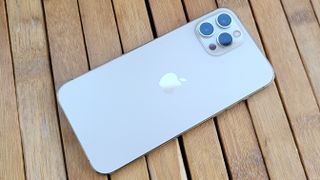
Other than their dimensions, the iPhone 12 Pro and iPhone 12 Pro Max’s core design elements are the same. Apple opted for a flat-edge, iPhone 4-esque design that reminds me of a thick candy bar cloaked in luxurious wrapping. “Pacific Blue,” by and large, is everyone’s favorite Pro and Pro Max color ahead of all the other three options: Silver, Gold and Graphite.
Moving on to the display, both phones sport ultra-slim bezels and an unsightly notch that houses the 12MP selfie camera, hindering the display from offering a high screen-to-body ratio. Many Apple fans don’t care about the notch, but after feasting my eyes on screen-spacious phones like the Samsung Galaxy S21 and the LG Wing, the notch is unbecoming.
You’ll find a silencer button and the volume buttons on the left side of both phones. On the right edge is a side button that can be used to awaken the device and activate Siri. On the bottom edge is a set of Dolby Atmos speakers and mics; you’ll also find a lightning port for charging.
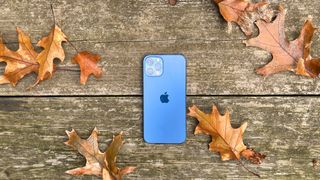
The rear features a triple-camera setup. Both the Pro and the Pro Max have three 12MP lenses: ultra-wide, wide and telephoto. The duo is also equipped with a LiDAR scanner. While both camera setups look similar, the Pro and the Pro Max have different hardware, which we’ll discuss later in this face-off.
The upper-tier iPhone 12s are also made of the same material: surgical-grade stainless steel. Both phones have a fingerprint-averse matte finish while the opposite is true for the edges, which have a glossy, fingerprint-attracting coating. Feel free to chill with the Pro and the Pro Max by the pool; both phones have an IP68 rating, which means they can endure six meters of water submersion for up to 30 minutes.
With the iPhone 12 Pro Max offering a larger screen (and I’m a sucker for spacious displays), it’s the clear winner in this round.
Winner: iPhone 12 Pro Max
iPhone 12 Pro vs. iPhone 12 Pro Max: display
The iPhone 12 Pro and the iPhone 12 Pro Max share the following display features: OLED with HDR, - Super Retina XDR resolution, True Tone, a 60Hz screen, and a 2,000,000-to1 contrast ratio.
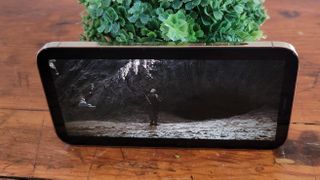
As mentioned, the iPhone 12 Pro has a 6.1-inch display and the iPhone 12 Pro Max has a 6.7-inch screen. The Pro has a 2532 x 1170-pixel panel, equating to 460 pixels-per-inch (ppi) while the Pro Max has a 2778 x 1284-pixel display, equating to 458 ppi. Though the ppi for the Pro Max is slightly lower, the difference is imperceptible to the naked eye.
Like the iPhone 12 and iPhone 12 mini, the Pro and the Pro Max are equipped with Ceramic Shield displays — glass panels that are infused with crystalline structures to toughen the screen against drops. Apple boasts that the iPhone 12 line has the world’s most durable display, but don’t be too reckless; third-party drop-test results revealed that the iPhone 12 Pro will still shatter upon impact.
To test the displays, we watched the Free Guy trailer on the iPhone 12 Pro and The Mandalorian on the iPhone 12 Pro Max. We were impressed with the eye-catching, crisp colors that popped on the iPhone 12 Pro as Ryan Reynolds kicked some serious butt in a vibrant, video-game world. When we watched The Mandalorian on Disney Plus (a Dolby Vision HDR-supported show), we were taken aback by the deep blacks and rich hues that emanated from the display. Even during scenes with bland palettes (like the desert), the Pro Max delivered impressive visuals.
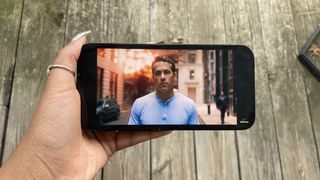
One gripe that we have with the Pro and Pro Max’s displays are their 60Hz screens, which pale in comparison to the displays featured on high-end Android flagships like the Samsung Galaxy Note 20 Ultra. After getting a taste of a smooth, 120Hz refresh rate on a vibrant, 6.9-inch AMOLED display, the iPhone Pro and iPhone 12 Pro Max are slightly disappointing. Rumor has it that Apple planned to equip the iPhone 12 line with 120Hz panels, but due to supply-chain issues, the Cupertino-based tech giant couldn’t pull it off.
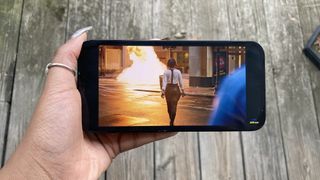
According to our colorimeter, the iPhone 12 Pro covers 81.9% of the DCI-P3 color gamut while the iPhone 12 Pro Max’s coverage widens to 84.8%. The Pro offers 743 nits of brightness while the Pro Max is dimmer (655 nits). With the Pro serving up a brighter screen than its pricier sibling, it reigns supreme in this round.
Winner: iPhone 12 Pro
iPhone 12 Pro vs. iPhone 12 Pro Max: performance
The iPhone 12 and the iPhone 12 Pro are powered by the A14 bionic chip, the world’s fastest smartphone SoC. Both phones are packed with 6GB of RAM. When we flooded the Pro and the Pro Max with an avalanche of apps to test their multitasking muscles, the upper-tier Apple phones stood strong against the blitzkrieg and said, “Pfft! You’re going to have to do better than that!” If you tend to run countless apps simultaneously, the Pro and the Pro Max will have no issues handling your onslaught of heavy productivity.
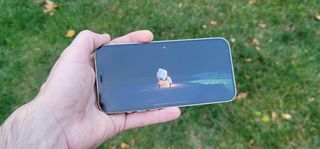
On the Geekbench 5.0 overall performance test, the iPhone 12 Pro served up a score of 3,669, which couldn’t compete with the iPhone 12 Pro Max’s 4,111 score. On the Jetstream 2.0 benchmark, a web-browser test designed to measure JavaScript performance, the Pro offered a score of 169.2, which, again, falls short of the Pro Max’s zippy 200.4.
In our Adobe Premiere Rush video editing test, the Pro took 27 seconds to finish rendering a set of tasks; the Pro marginally outpaced the Pro Max, which completed the test in 29 seconds. On the 3DMark Wild Life graphics performance benchmark, the Pro reached a score of 6,567 (39 frames per second) while the Pro Max edged out the lower-priced model by a nose with a score of 6,618 (also 39 frames per second).
Although the iPhone 12 Pro Max outperformed the iPhone 12 Pro in most tests, it wasn’t by a landslide. Still, with the Pro Max having the edge over its lower-priced sibling, it’s only fair that the Pro Max gets the win.
Winner: iPhone 12 Pro Max
iPhone 12 Pro vs. iPhone 12 Pro Max: battery life and charging
The battery capacity of the iPhone 12 Pro and the iPhone 12 Pro Max are 2,815 mAh and 3,687 mAh, respectively. As you’d expect, the Pro’s runtime is shorter than the Pro Max.
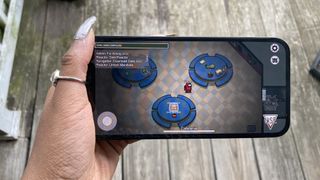
According to results from the Laptop Mag battery test (continuous surfing over the AT&T network at 150 nits of brightness), the iPhone 12 Pro lasted 9 hours and 5 minutes. The iPhone 12 Pro Max lasted almost two hours longer with a runtime of 10 hours and 53 minutes.
Now let’s address the pink elephant in the room: none of the iPhone 12 variants come with power bricks in their boxes, so you’ll need a USB-C power adapter to use the USB-C-to-lightning charging cable, which ships with the Pro and the Pro Max. You’ll need the same power adapter for the MagSafe wireless charging pad (sold separately) that Apple is hawking; it, too, does not come with a power brick.
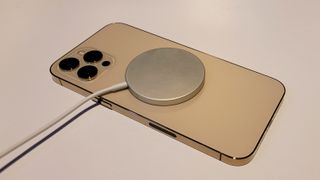
We used a 20W power brick and the MagSafe charging pad to power up the iPhone 12 Pro and the iPhone 12 Pro Max. The iPhone 12 Pro charged to 12% after 15 minutes and 29% after 30 minutes. The Pro Max, on the other hand, charged to 23% after 15 minutes and 47% after 30 minutes.
The iPhone 12 Pro Max will give you more juice while you’re away from an outlet, so the pricier configuration is the clear winner in this round.
Winner: iPhone 12 Pro Max
iPhone 12 Pro vs. iPhone 12 Pro Max: cameras
The iPhone 12 Pro Max is packed to the brim with Apple’s latest camera tech. The Pro Max comes with a 12MP front-facing camera and three 12MP rear cameras: a wide, ultra-wide and telephoto lens. It also has a LiDAR sensor, too, for better low-light performance and advanced AR experiences.
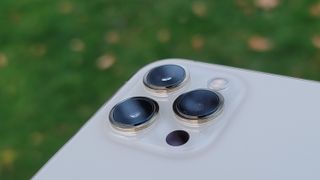
The iPhone 12 Pro has the same setup, but the difference lies in hardware specs. The Pro Max’s 1.7μm wide camera sensor is 47% larger than the Pro’s 1.4µm wide lens. To put this into perspective, Apple says that the Pro Max’s larger sensor improves low-light photos by a whopping 87%.

iPhone 12 Pro (wide lens)

iPhone 12 Pro Max (wide lens)
The iPhone 12 Pro Max also has a longer range with a 5x optical zoom range and up to 12x for digital zoom. The iPhone 12 Pro has a 4x optical zoom range and up to 10x for digital zoom. Lastly, the Pro Max sports an ƒ/2.2, 65mm telephoto lens while the Pro features a ƒ/2.0, 52mm telephoto lens. In this case, higher isn’t better — the number after “f” represents the aperture width. The lower the number, the wider the aperture, which means more light comes in. As a result, your pictures will be brighter and sharper.
How is LiDAR useful?
LiDAR stands for Light Detection and Ranging. The LiDAR sensor on the Pro and Pro Max shoots lasers to perceive depth information. Consequently, the LiDAR sensor enhances Night Mode performance, dramatically improving autofocus in low-light environments.
Check out these stunning, ultra-wide Night Mode shots we took on the iPhone 12 Pro and the iPhone 12 Pro Max. On the iPhone 12 Pro’s Night Mode photo, I can see a faint cloud peeking behind the store’s gable. You can also get a sense of the different textures that pop in the photo, including the cracked, coarse asphalt and the brick facade of the store, emanating different shades of tan and brown. On the Pro Max, the red, mint green, yellow and blue neon lights jump out at you, capturing the diner’s glowy allure.

iPhone 12 Pro (ultra-wide)

iPhone 12 Pro Max (ultra-wide)
LiDAR is also advantageous for AR experiences that you can download from the Apple App Store. I had a lot of fun playing around with a museum app that allowed me to “hang up” iconic paintings on my dining room wall, such as Grant Wood’s American Gothic and Leonardo da Vinci’s Mona Lisa.
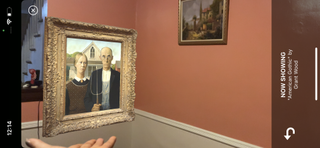
Selfies
The f/2.2, TruthDepth front-facing camera sports the Pro and the Pro Max’s only form of biometric authentication: Face ID. I do miss Apple’s fingerprint scanner — using Face ID in a world filled with mask mandates is incredibly inconvenient. Thankfully, the Cupertino-based tech giant is making some strides to rectify this issue by allowing users to unlock their iPhones via an Apple Watch.
As for selfies, the Pro and the Pro Max’s photos lean toward serving up a cooler palette while flagship Samsung devices offer warmer, smoother tones. Which is better? It all depends on your personal taste. Social media influencers will also love playing around with the Pro and Pro Max’s camera effects (i.e. Natural, Studio, Contour, Stage, Stage Mono and High-Key Mono). Portrait mode is my favorite, offering eye-catching bokeh effects. Check out our gallery of selfies to get a good idea of how your own pictures would turn out if you snagged one of Apple’s upper-tier phones.

Selfie on iPhone 12 Pro Max

Selfie on the iPhone 12 Pro

Selfie on the iPhone 12 Pro Max (High-Key Mono)

Selfie on the iPhone 12 Pro (High-Key Mono)
Video
The iPhone 12 Pro and the iPhone 12 Pro Max blesses users with 4K, 60 frames-per-second HDR recording, editing and sharing with Dolby Vision (a professional-grade, cinematic video format that provides life-like colors, rich blacks and brighter highlights). Users can edit Dolby Vision videos directly on the Pro and the Pro Max, which hasn’t been possible on any smartphone until now. I’m no YouTuber, but when I pretended to be a vlogger while using the Pro’s front-facing camera, I was impressed with the crystal clear, true-to-life, sharp videos it produced.
The Pro and the Pro Max also supports Apple ProRAW, a format that lets photographers to access uncompressed images for easy photo manipulation on your favorite editing programs such as Lightroom and Photoshop. Overall, with the Pro Max offering a larger sensor for the wide lens, I have to give the win to the top-tier Apple device.
Winner: iPhone Pro Max
Overall winner: iPhone 12 Pro Max
Although I was rooting for the underdog (the iPhone 12 Pro), it could not stand up to the iPhone 12 Pro Max’s Herculean performance. The iPhone 12 Pro pulled out a few surprise wins on the Adobe Premiere Rush video editing benchmark and brightness test, but it wasn’t enough to take down the gargantuan iPhone 12 Pro Max.
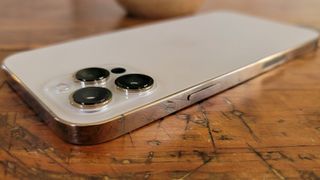
The Pro Max won this face off for its decent battery runtime (10 hours and 53 minutes), larger display, wider DCI-P3 color coverage and knock-out overall performance. The 6.7-inch device isn’t just a beast among the iPhone 12 variants — it’s an intimidating titan in the smartphone industry as a whole.
I do believe the iPhone 12 Pro Max is worth the extra $100 — that additional two hours of battery life is valuable. Still, if you prefer to pocket your hard-earned Benjamins, the Pro is an excellent choice, serving up scores that trailed closely behind the Pro Max. Whether you snag the Pro or the Pro Max, you’ll be satisfied with your investment.
Kimberly Gedeon, holding a Master's degree in International Journalism, launched her career as a journalist for MadameNoire's business beat in 2013. She loved translating stuffy stories about the economy, personal finance and investing into digestible, easy-to-understand, entertaining stories for young women of color. During her time on the business beat, she discovered her passion for tech as she dove into articles about tech entrepreneurship, the Consumer Electronics Show (CES) and the latest tablets. After eight years of freelancing, dabbling in a myriad of beats, she's finally found a home at Laptop Mag that accepts her as the crypto-addicted, virtual reality-loving, investing-focused, tech-fascinated nerd she is. Woot!